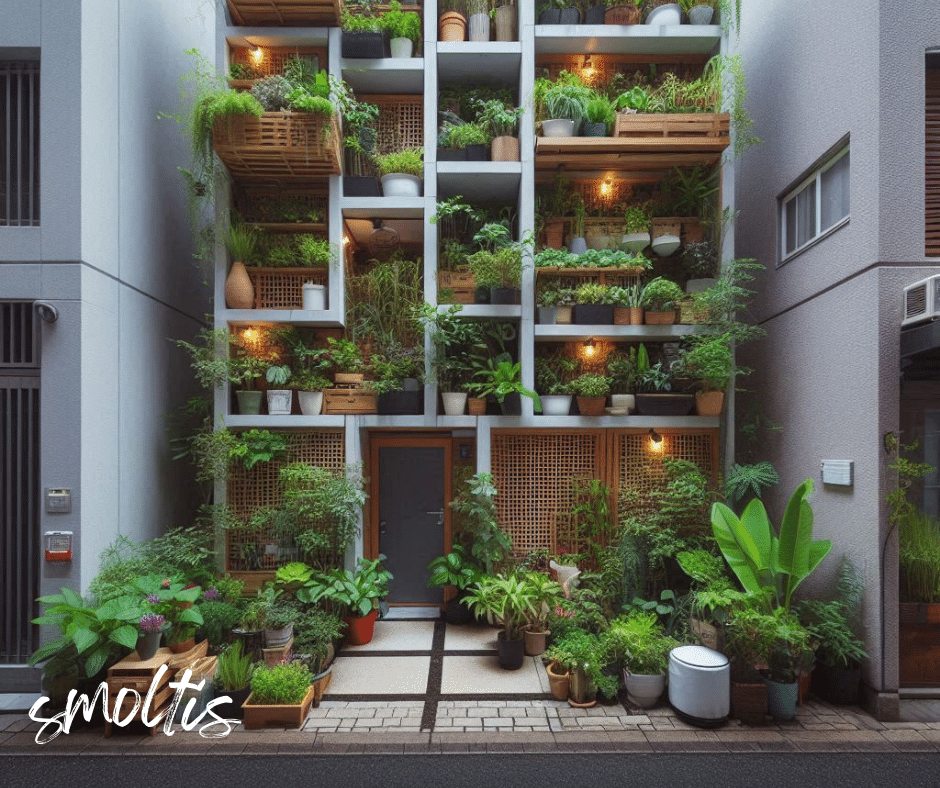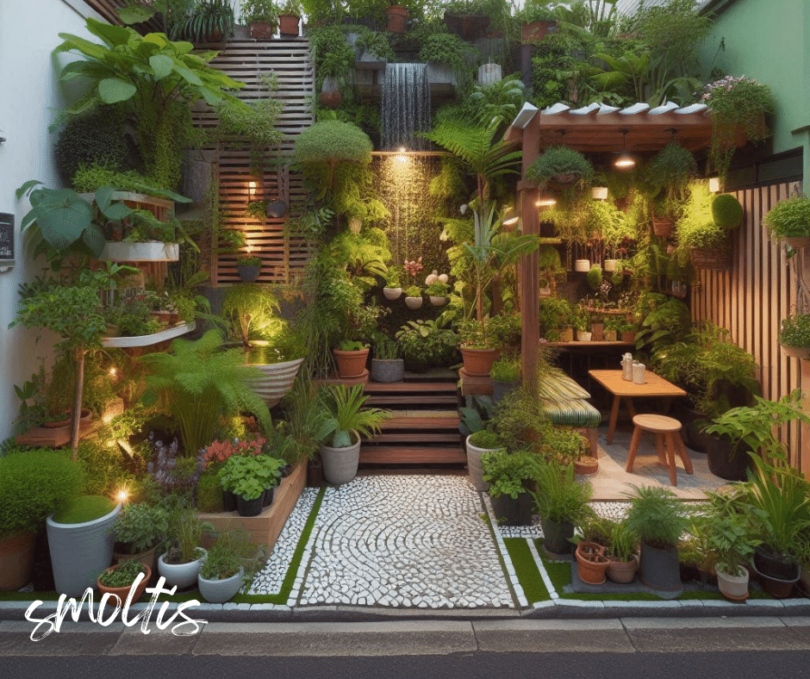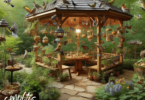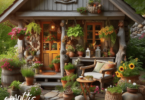In the heart of bustling cities, where towering buildings and concrete landscapes often dominate the skyline, a growing trend is transforming urban living – the creation of lush, compact shade gardens. These serene oases, tucked away in small patios, balconies, and shady corners, offer a tranquil respite from the surrounding hustle and bustle. Whether you have a patio, balcony, or a shady nook in your yard, this comprehensive guide will explore the art of cultivating a thriving shade garden in your limited urban space.

Shade gardens thrive in areas with limited direct sunlight, such as under trees, on north-facing walls, or in the shadows cast by buildings. These gardens can provide a peaceful, private retreat and create a serene atmosphere in small, confined spaces. By carefully selecting low-light, understory plants and incorporating vertical and layering techniques, you can transform your urban landscape into a lush, verdant sanctuary.
From planning and design to plant selection and maintenance, this article will unlock the secrets to creating your own compact shade garden. Discover the benefits of shade gardening in urban environments and learn how to maximize your limited space to curate a thriving, peaceful retreat right in your own backyard.
Key Takeaways
- Shade gardens can thrive in small urban spaces, providing a peaceful and private retreat.
- Carefully selecting low-light, understory plants is key to creating a successful shade garden.
- Incorporating vertical and layering techniques can help maximize limited space in compact gardens.
- Shade gardening offers numerous benefits, including enhanced privacy, reduced heat absorption, and a calming, naturalistic ambiance.
- With the right planning and design strategies, you can transform your urban oasis into a lush, thriving shade garden.
Embracing the Beauty of Shade
In the bustling urban landscape, shade gardens offer a refreshing respite from the glare of the sun. These unique garden havens thrive in areas with limited direct sunlight, such as under the canopy of trees, on north-facing walls, or in the shadows cast by towering buildings. By embracing the beauty of shade, homeowners and city dwellers can transform small, confined spaces into serene, private retreats that exude a sense of tranquility.
Understanding the Concept of Shade Gardens
Shade gardens are designed to capitalize on the unique growing conditions found in areas with partial or full shade. Unlike their sun-loving counterparts, these gardens showcase a diverse array of low-light gardening plants that flourish in the filtered light and cooler temperatures. From lush understorey planting to vibrant woodland gardening displays, shade gardens offer a captivating alternative to traditional sun-drenched landscapes.
Benefits of Creating Shade Gardens in Urban Areas
In the hustle and bustle of the city, shade gardens in small spaces provide a much-needed haven for urban dwellers. These compact garden design solutions not only enhance privacy and create a sense of seclusion but also help mitigate the heat absorption common in dense urban environments. By incorporating screening plants for privacy and vertical garden walls, homeowners can transform their shady corners and balconies into calming urban shade gardening retreats.
Moreover, shade gardens can serve as a sanctuary for wildlife, attracting a diverse array of birds, pollinators, and other beneficial creatures that thrive in the partial sun plants and sheltered microclimate. This, in turn, contributes to the overall biodiversity and ecological balance of the urban landscape.
Planning Your Compact Shade Garden
When it comes to creating a thriving shade garden in a small urban space, thoughtful planning is key. Begin by assessing your available space and evaluating the light conditions, from deep shade to partial sun. Understanding the unique lighting challenges of your area will be essential in selecting the appropriate low-light, shade-loving plants that will thrive in your compact oasis.
Assessing Your Space and Light Conditions
Take the time to carefully examine your designated garden area, noting the size, shape, and any existing structures or features that may impact the light levels. Observe how the sun moves across the space throughout the day, identifying areas that receive direct sunlight, dappled light, or remain in deep shade. This analysis will inform your plant selection and the overall design of your compact shade garden.
Choosing the Right Plants for Shade Gardens in Small Spaces
With a clear understanding of your light conditions, you can now explore a diverse array of low-light, partial sun plants that will flourish in your compact shade garden. Consider foliage plants that add texture and color, such as ferns, hostas, and caladiums, as well as flowering perennials and annuals that will bring seasonal interest to your urban oasis. Incorporate underplanting species, like ground covers and low-growing shrubs, to create a layered, woodland-inspired aesthetic.
Designing for Visual Interest and Functionality
As you plan the layout of your compact shade garden, focus on creating a visually appealing and functional space. Utilize vertical elements, like trellises and wall-mounted planters, to maximize your limited footprint and introduce height and depth. Arrange your plants in a way that showcases their unique foliage and bloom patterns, while also considering factors such as privacy, circulation, and the creation of cozy, shaded seating areas. By carefully balancing aesthetics and functionality, you can transform your small, shady corner into a serene and inviting urban retreat.
Shade Gardens in Small Spaces
When working with limited urban spaces, it’s essential to explore practical solutions to create thriving shade gardens. One such solution lies in the power of
Vertical Gardening Solutions
.
By utilizing walls, trellises, and hanging baskets, you can maximize your available square footage and grow a diverse array of shade-loving plants. Vertical gardening allows you to layer foliage, flowers, and even edibles, transforming compact areas into lush, multi-dimensional oases. This technique not only saves precious ground space but also adds visual interest and a sense of depth to your small shade garden.
Complementing the vertical approach,
Incorporating Understory Plants
can further enhance the richness and complexity of your compact shade garden. Understory plants, such as ferns, hostas, and begonias, thrive in the dappled light and shaded conditions found in urban environments. These resilient, low-growing species can create a seamless, harmonious tapestry that adds texture, color, and a sense of tranquility to your small outdoor haven.
When seeking to create cozy, private nooks within your compact shade garden,
Creating Cozy Nooks with Screening Plants
can be a game-changer. Strategically placing tall, dense plants like evergreen shrubs or vines can effectively screen off areas, providing a sense of enclosure and intimacy. These screening plants not only offer privacy but also serve as living walls, softening the boundaries of your small space and adding another layer of visual interest.
By embracing vertical gardening, incorporating understory plants, and strategically utilizing screening plants, you can transform even the most limited urban spaces into lush, serene shade gardens that offer a peaceful respite from the bustling city. These practical solutions allow you to maximize your available square footage and cultivate a thriving, private oasis right in your own backyard.
Low-Light Gardening Techniques
Cultivating a thriving shade garden in small urban spaces requires a deep understanding of specialized low-light gardening techniques. Proper soil preparation is crucial, as shade-loving plants often thrive in well-draining, nutrient-rich soil that retains moisture. By amending your soil with organic matter, such as compost or peat moss, you can create the ideal growing medium for your shade gardens in small spaces and low-light gardening needs.
Soil Preparation for Shade Gardens
One of the key aspects of successful low-light gardening is ensuring your soil is well-suited to the unique requirements of partial sun plants. Start by testing your soil’s pH levels and adjusting them as needed to create the optimal acidic or neutral environment for your chosen understorey planting. Incorporate generous amounts of compost or well-rotted manure to enhance the soil’s water-holding capacity and provide a steady supply of nutrients for your shady corner gardens.
Watering and Maintenance Tips
In compact garden design, water management is critical, as shade-loving plants often have different watering needs compared to their sun-loving counterparts. Adjust your watering schedule to accommodate the reduced evaporation rates in your urban shade gardening oasis. Avoid overwatering, as this can lead to root rot and other issues. Additionally, be mindful of mulching around your plants to retain moisture and suppress weed growth, ensuring your screening plants for privacy and woodland gardening thrive in the vertical garden walls of your compact space.
Partial Sun Plant Selections
When designing your compact shade garden, it’s important to select plants that can thrive in the partial sun conditions often found in urban environments. These versatile partial sun plants can add texture, color, and seasonal interest to your shady oasis, transforming your small space into a lush and captivating retreat.
Foliage Plants for Texture and Color
Incorporate a variety of foliage plants that excel in partial sun, such as ferns, hostas, and caladiums. These plants offer a wide range of leaf shapes, sizes, and hues, creating visual depth and a sense of lushness in your compact shade garden. Ferns, with their delicate and intricate fronds, can add a touch of elegance, while bold-leaved hostas and caladiums provide striking color and contrast.
Flowering Plants for Seasonal Interest
To add bursts of color and seasonal interest to your shade garden, consider including partial sun-loving flowering plants. Shade-tolerant perennials like astilbe, Japanese anemone, and begonia can provide a stunning display of blooms throughout the growing season, brightening up your compact urban oasis. These flowering plants not only add visual appeal but also attract pollinators, further enhancing the natural charm of your shade garden.
By carefully selecting a diverse range of partial sun plants, you can create a harmonious and visually striking shade garden that thrives even in the most challenging urban environments. From lush foliage to vibrant flowers, these versatile plants will transform your small shady space into a true oasis of tranquility and beauty.
Compact Garden Design Strategies
When working with limited urban spaces, strategic garden design becomes essential to creating a thriving, visually captivating shade garden. By incorporating vertical elements and layering techniques, you can maximize your available square footage and transform even the most confined areas into lush, inviting oases.
Incorporating Vertical Elements
Take advantage of vertical space by utilizing trellises, hanging baskets, and wall-mounted planters to grow a variety of shade-loving vines, climbers, and cascading plants. These vertical elements not only add depth and visual interest to your compact shade garden but also help to create the illusion of a larger, more expansive space.
Maximizing Small Spaces with Layering
Embrace the art of layering to pack more plants into your limited square footage. Strategically arrange taller, upright partial sun plants at the back, followed by medium-sized understory plants in the middle, and finish with low-growing, trailing ground cover species at the front. This layered approach creates a sense of depth and visual interest while maximizing the available space.
Creating Focal Points and Visual Flow
Establish focal points within your compact shade garden to draw the eye and create a harmonious, visually engaging layout. Incorporate eye-catching specimen plants, sculptural features, or even a small water fountain to serve as the centerpiece. Thoughtfully position these elements to guide the viewer’s gaze and create a sense of movement and flow throughout the garden.
| Vertical Gardening Techniques | Layering Strategies | Focal Point Ideas |
|---|---|---|
| Trellises for climbing vines | Upright partial sun plants at the back | Specimen plants with unique foliage or flowers |
| Hanging baskets for cascading plants | Medium-sized understory plants in the middle | Sculptural features like small fountains or statues |
| Wall-mounted planters for vertical interest | Low-growing ground cover plants at the front | Pathways or seating areas to guide the eye |
Conclusion
As you embark on your journey to transform a small, shady urban space into a lush, verdant oasis, the insights and strategies explored throughout this comprehensive guide will be your invaluable companions. By embracing the beauty of shade gardens, you can create a private retreat that not only enhances your living environment but also provides numerous benefits, from increased privacy and reduced heat absorption to a calming, naturalistic ambiance.
Whether you’re working with a compact patio, a shaded corner of your yard, or a balcony with limited sunlight, the principles of low-light gardening, partial sun plant selection, and innovative compact garden design will empower you to cultivate a thriving and visually captivating shade garden. Explore the versatility of vertical gardening solutions and the depth-enhancing potential of understory planting and screening plants for privacy.
As you continue to refine and nurture your urban shade garden, remember that the true beauty lies not only in the lush foliage and delicate blooms but also in the sense of tranquility and reconnection with nature that it fosters. Embrace the power of woodland gardening principles to create a serene oasis that nourishes both your body and soul, allowing you to escape the hustle and bustle of city life and bask in the soothing embrace of your very own compact shade garden.
FAQ
What is a shade garden?
A shade garden is a type of garden that thrives in areas with limited direct sunlight, such as under trees, on north-facing walls, or in the shadows cast by buildings. These gardens provide a peaceful, private retreat and create a serene atmosphere in small, confined spaces.
What are the benefits of creating a shade garden in an urban area?
Shade gardens offer several benefits in urban environments, including providing a private, tranquil oasis, reducing heat absorption, and fostering a calming, naturalistic ambiance. They can also help screen unsightly views and create privacy in small outdoor spaces.
How do I choose the right plants for my shade garden?
When selecting plants for your shade garden, it’s important to consider the specific light conditions in your area, ranging from deep shade to partial sun. Look for shade-loving plants that thrive in low-light conditions, such as ferns, hostas, and begonias. Incorporate a variety of foliage plants for texture and color, as well as some flowering plants to add seasonal interest.
What are some tips for designing a compact shade garden?
To design a compact shade garden, focus on incorporating vertical elements like trellises, hanging baskets, and wall-mounted planters to maximize your limited space. Use layering techniques to create depth and visual interest, and strategically place focal points to draw the eye. Consider using screening plants to create cozy nooks and enhance privacy.
How do I prepare the soil for a shade garden?
Proper soil preparation is crucial for a successful shade garden. Look for well-draining, nutrient-rich soil that retains moisture. You may need to amend the soil with organic matter, such as compost, to ensure it meets the specific needs of your shade-loving plants.
What are some low-light gardening techniques I can use in my shade garden?
In addition to choosing the right plants, there are several low-light gardening techniques you can employ, such as carefully monitoring watering needs, providing adequate mulch to retain moisture, and selecting the appropriate fertilizers to support your shade-loving plants.







